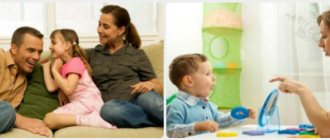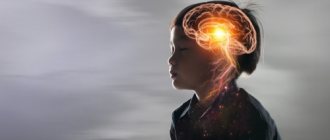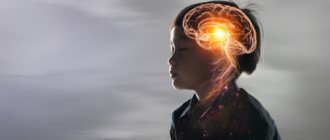Currently, there are three main types of pathology:
- Motor or expressive alalia. This is the child's inability to produce sounds. The child understands all words and can show their meaning with gestures. But the pronunciation is missing.
- Sensory or impressive alalia manifests itself in the fact that the baby does not perceive extraneous speech. He can speak without perceiving the speech addressed to him as if on his own.
- Sensorimotor, mixed alalia, has the characteristics of the two above in different proportions.
In sensorimotor alalia, the entire sensorimotor area of the cerebral cortex is affected. Sick children not only do not understand what their parents say, but they also cannot speak. This form of pathology is sometimes called total. Often, a child with total alalia cannot speak at all. In 100% of cases, the disease is accompanied by intellectual retardation. This disease is the most difficult to treat, and even an integrated approach sometimes does not guarantee a positive prognosis.
Symptoms
Sensorimotor alalia represents the immaturity of speech functionality at a fairly deep level. In most cases, it is possible to diagnose the problem in preschool age, when it is possible to correct its development and provide the child with a normal subsequent life.
The disease may be systemic or widespread. In other words, the violation affects all components of speech at once and manifests itself quite specifically.
There are several signs that become most typical for sensorimotor alalia:
- Minimum vocabulary.
- Late formation of speech functionality.
- Inarticulate pronunciation, problems with pronunciation.
- Problems of syllabic structure.
The pathology has a pronounced manifestation. The symptoms of the problem are represented by various manifestations. Among the main ones are:
- Problems with coordination.
- Fine motor defects.
- Awkwardness.
- Problems with self-care, such as buttoning buttons or tying shoelaces.
- Impaired attention, reaction, memory, concentration.
- Hyperactivity or inertia and increased fatigue depending on the child and the nature of the injury.
- Understanding someone else's speech, but not the ability to perform independent speech.
- Delay in the formation of speech skills.
- Inability to repeat after other people.
- Stuttering.
- Articulation problems.
- Small vocabulary.
Neurological manifestations can also be identified. This may be a lack of understanding of the addressed speech, high speech activity, but the baby speaks his “own” language, severe violations of phonemic hearing.
Clinical picture and behavioral characteristics of children
Children with motor alalia are distinguished by the following characteristics:
- Preserved intelligence. The child learns normally, understands gestures, recognizes pictures, and recognizes familiar people.
- Incorrect use of voice. Your baby may speak too loudly or too softly.
- Incorrect pronunciation of words and sentences (the child does not speak, but rather babbles), while voiced and soft consonants sound correctly.
- The baby does not respond to questions and finds it difficult to answer.
There is also a more severe form of alalia: with it, the child understands the address, but does not speak at all.
In addition to speech problems, a child may exhibit other typical symptoms, for example, children often experience fatigue, especially during learning. Excessive activity, interspersed with periods of fatigue, is common. Many children experience either severe inhibition or severe disinhibition, depending on the characteristics of the injury.
Important! Alalia does not occur due to stress or difficult life events. Its cause is brain damage, not fear or psychological trauma.
Causes
Sensorimotor alalia can develop in the antenatal, intranatal and early periods of child development up to the age of three. Accordingly, specific provoking factors are directly related to the process of formation and growth of the child’s body at different stages of his life.
In the antenatal or intranatal period, the disease can develop against the background of the following factors:
- Threats of spontaneous termination of pregnancy (miscarriage);
- Intrauterine infection with microorganisms of the TORCH complex;
- Prolonged and severe fetal hypoxia (such a disorder can be associated not only with obstetric pathologies, but also with exogenous factors such as maternal smoking, etc.);
- Severe toxicosis;
- Falls of a pregnant woman associated with injury to the fetus;
- Somatic diseases of the expectant mother in a chronic form (this category includes hypotension, hypertension, heart failure and other systemic pathologies of a permanent type).
The development of complicated sensorimotor alalia with autistic features can also occur in the perinatal period, i.e. at delivery. Typically, pathological processes in this case are associated with intracranial birth injuries, prematurity and asphyxia of newborns.
Disturbances in the cerebral cortex also often occur against the background of too transient, rapid natural childbirth, or in the opposite case, when a woman gives birth for too long. This occurs less frequently when using instrumental obstetric aid, including delivery by cesarean section.
If we talk about the development of the disorder in the first years of a baby’s life, it can be triggered by meningitis, encephalitis and head injury.
Diagnosis of sensory alalia in children
Due to the diversity of the causes and mechanisms of development of the pathology, the diagnosis of sensory alalia consists of two parts: a medical examination and a psychological and pedagogical consultation. The medical part is aimed at identifying organic brain damage, neurological, mental disorders, diseases of the ear, nose and throat, which are characterized by lack of speech.
The examination is phased and includes:
- Neurological research methods - examination by a neurologist, analysis of the course of pregnancy in the mother, childbirth and the early postpartum period. The doctor examines the child’s outpatient record, specialist reports in the first year of life, and identifies previous diseases. Looks at the results of analyzes and instrumental research methods. If necessary, the neurologist prescribes skull radiography, echoencephalography, electroencephalography, MRI or CT scan of the brain;
- Examination by an ENT doctor to exclude organic damage to the organ of hearing and congenital deafness. Audiological diagnostics, audiometry, and tympanometry are performed. The child is cared for by an otorhinolaryngologist, and sometimes an audiologist is involved;
- Consultation with a speech therapist is one of the important parts of diagnosing sensory alalia. The specialist comprehensively studies the characteristics of speech, identifies early speech and neuropsychic development. Evaluates impressive speech, that is, speech understanding. The specialist gives simple commands that the baby must follow: show an object, make some movement, repeat syllables or words. These methods allow the speech therapist to understand the nature of the disorders;
- A consultation with a psychologist is necessary to assess the state of auditory-verbal memory, the baby’s behavior, and identify deficits in mental functions. Based on the obtained picture, the specialist determines the tactics for managing the patient.
In most cases, several consultations with specialists are required. This is due to the variability of the clinical picture with sensory alalia: sometimes the child easily gives in to contact, sometimes he refuses to communicate.
Also, the difficulty of diagnosis is associated with the need to exclude other speech disorders and mental disorders. For example, it is necessary to exclude autistic disorders, sensorineural hearing loss, aphasia, and mental pathology.
Treatment
Treatment is carried out in several directions.
Speech therapy exercises. Can be carried out individually or within a special school. Positive results are achieved only by systematic, long-term training.
Under the guidance of a speech therapist, the child gradually masters the pronunciation of individual syllables and words and recognizes speech by its sound. With the help of various pictures, the skills of linking them with specific words are acquired.
When certain progress has been made, the child is already able to name one or another object shown in the picture. Gradually, the baby masters the correct endings of words, cases and declensions.
Additionally, classes are conducted that develop fine motor skills using drawing, modeling, cutting, and construction toys.
The success of treatment largely depends on home exercises. Exercises conducted with a speech therapist should be constantly reinforced with the direct participation of parents.
Speech therapy massage. Considered an effective addition to exercise. It develops individual muscles of the oral cavity responsible for correct pronunciation. The procedure is performed manually or using a special probe. Additionally, speech muscles are developed with the help of specific exercises designed specifically for these purposes.
Physiotherapeutic procedures. They are prescribed in the form of specific courses, depending on the child’s condition. They can be supplemented with hydrotherapy, magnetotherapy, laser therapy and other procedures.
Reflexology. Its essence is to stimulate the necessary areas of the brain with electrical impulses. This leads to the formation of new neural connections that facilitate learning. Applies to children over 9 years of age.
Drug therapy. Includes the use of drugs that stimulate blood flow to the brain. Additionally, vitamins B12 and B15 are prescribed. Much attention is paid to a balanced diet.
Prognosis and prevention
The prognosis for sensory alalia depends on the timeliness of starting therapy. With a mild degree of impairment, active participation of parents in correction, and regular classes with a speech therapist, the result will be good. Speech disorders are eliminated and complications are prevented. The child acquires communication skills, communicates freely with peers, and can master the school curriculum.
With late treatment and lack of proper attitude on the part of parents, lack of regularity of classes, recovery is in question, unfortunately.
Prevention of sensory alalia
Prevention of speech disorders, as well as other health problems, begins at the stage of pregnancy planning. A woman needs to undergo diagnostics to identify health problems. Then correct the detected violations. Only after this can you plan to conceive.
During pregnancy, it is important to follow the doctor’s recommendations: undergo examinations and tests on time. If necessary, take medications and vitamins. Lifestyle and nutrition play an important role - a pregnant woman and her unborn baby need food rich in vitamins and microelements, adequate sleep and rest, and fresh air for proper development. Stress, intoxication, bad habits, and work in hazardous working conditions should be excluded.
It is necessary to prevent damage to the central nervous system during childbirth, in the early postnatal period and the first year of life.
Parents need to be especially careful if there is a person in the family with speech impairments. Children, especially small ones, repeat with adults: in this way he can copy an adult who speaks poorly or does not speak at all.
We also want to draw parents’ attention to the fact that sensory alalia does not go away on its own in children. This is a serious speech therapy, psychological, and sometimes psychiatric pathology with many causes, which can only be overcome with the joint efforts of doctors, parents and the child himself. Therefore, we recommend that you contact a specialist as soon as possible if signs of sensory alalia are detected and begin treatment.
Forecast
In most cases, with timely treatment, children recover. Over time, their speech becomes understandable, and in terms of intellectual development, such a child will not lag behind his peers. But in some cases, due to the advanced form of alalia, doctors cannot guarantee complete relief from this disease.
Sign up for a consultation. The children's speech therapist and psychologist of the center will determine the individual causes of alalia, give recommendations for correction, and also draw up a plan for classes in the center and at home. This system of work will make the correctional route the most effective and will successfully harmonize the baby’s development process.
Complications of sensory alalia
Impaired sound perception leads to incorrect pronunciation and unformed expressive speech. An additional symptom of sensory alalia is general speech underdevelopment. It is difficult for such children to master school material due to disorders of learning skills - impaired writing and reading. They find it difficult to communicate with peers.
In later life, this causes signs of psychological disorders and emotional and volitional disorders. The intellect suffers and mental retardation develops. Children become unsociable, withdrawn, and live in their own little world.






